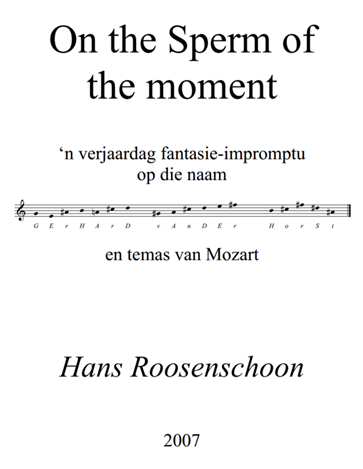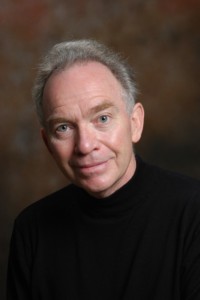On the sperm of the moment
Prologue by Gerhard van der Horst
It was indeed mentally a tough two years with Covid around and in my discussions with Microptic re the next blog I should write, I suggested that we do something light and full of fun before Christmas. I then suggested we do “On the sperm of the moment”. The story and the background are elaborated in a wonderful way below by my co-author, Prof Hans Roosenschoon, eminent South African composer and of great international reputation (see some biographical notes at the end – sorry for the pun). So, I am not going to spoil the fun beforehand and just briefly want to outline the structure of the blog:
- Prof Roosenschoon will be explaining with his typical humour and academic intensity the history and background to his music composition “On the sperm of the moment”, how it relates to me and particulalrly my Computer Aided Sperm Analysis research and Mozart.
- « On the sperm of the moment » must be heard and seen to be fully appreciated! For that purpose, see the video below combining the music and sperm motility and sperm images of many species of animals (the combination of the music and sperm images and editing was done by my youngest son Maximilian van der Horst)
- Some brief notes explaining some of the sperm motility patterns and images in the video
- Finally, and important: Brief biographical notes: Prof Hans Roosenschoon
Prof Hans Roosenschoon explains: On the sperm of the moment!
Can a sperm inspire music? Of course, it can!
There is a sperm that can take 50% credit for the genius that the composer Wolfgang Amadeus Mozart is still considered today. Perhaps his father, who was a musician too, played Bach’s famous organ piece, the Toccata and Fugue in D minor, just to be in the right mood for making love. Who knows? What we do know is that the ‘moment’ for the sperm and ovum cells was just right.
But I have my own story to tell.
Prof, Gerhard van der Horst, who I know as a world-renowned spermatologist, is a very good friend of mine since the early 80s. Over the years I have become aware of his ground-breaking research into the motility patterns of sperm cells in a variety of species. It is my impression, too, that his hypotheses on their behaviour have become seminal at national- and international conferences, in articles that appeared in accredited journals, as well as in the research of several of his PhD students.
I also know Gerhard as an ardent lover of classical music. During his school education he passed all his piano examinations with distinction. In particular, he has a soft spot for Mozart’s operas of which he has a huge collection on DVD. His knowledge about these works is astounding. More remarkable is the fact that wherever his sperm conferences take him, he always makes time to see a latest production of Mozart: Don Giovanni and The Magic Flute being two of his most favoured. But our friendship is also marked by Gerhard’s keen support of the music that I compose.
Because Gerhard uses music often to illustrate his videos on motility patterns, an idea occurred to us to collaborate. For instance, it appeared that in terms of phenomenology and morphology the characteristics of these patterns of collections/swarms of cells, versus the behaviour and trajectory of a single cell, could possibly be mapped and then translated into musical parameters when this data is projected according to x and y coordinates. Furthermore, there exists the possibility to transform the data from the digital images that Gerhard has collected with the help of digital transforming processes into synthesised sounds or let the data control other parameters of sonification.
Sadly, this project never materialised for reasons that are now unimportant. However, when we celebrated Gerhard’s 60th birthday in 2007, I dedicated a piano piece, On the Sperm of the moment, to him for the occasion. For starters, I created melodic figures based on his name, with the intention that these patterns, when played quickly, allude to swimming sperms:

But, without reference to the very famous operas by Mozart that Gerhard adored throughout his life, the piece would not be an apt celebration. So, Mozart got inserted as well. Finally, I included two well-known birthday songs: An Afrikaans one that is popular among children, and the most famous English one, Happy Birthday. A song often sung at weddings also makes an appearance. Fig. 1 shows the front page of the composition.
Some years after this, Gerhard asked me to realise my piano piece for electronic sounds, for it to accompany one of the videos he is now famous for. Once again it was a great pleasure for me to collaborate with him.

Fig. 1: Front page of the composition. Translation of sub-title: A birthday fantasy-impromptu on the name GErHArD vAnDEr HorSt and themes of Mozart
A final thought: An interesting experiment might be conducted by comparing the motility patterns with other types of motion patterns such as drumming and marimba music of Africa for instance.
Finale 1! The video and sperm explained: Gerhard van der Horst
In this Finale 1 a guide is provided to assist explaining the sperm swimming patterns and images in the video. Here sperm are typically presented in three forms (like the three chords at the opening of the Overture to the Magic Flute of Mozart): Swimming patterns of a wide range of species from black mussels to dolphins to rhesus monkeys are presented as some examples; as sperm images detailing their morphology/structure with light microscopy; and thirdly the inner fine details of the sperm by means of transmission electron microscopy. It is amazing how well Hans understands and captures many of these aspects with his “sperm moment” music.
In the video: Usually there is a picture of the animal/species followed either by the sperm swimming pattern or some or another structural feature analysed by CASA. And yes, indeed the rapid moving sperm is associated with the music progressing fast and vice versa but also then the stern morphological features associated with more dramatic slow chords. Once again, the genius of Hans in translating his music: “On the sperm of the moment” and what an honour to have collaborated with him on this!
Finale 2! Who is this famous composer? (Fig. 2) By Gerhard van der Horst
In sperm circles we know each other but here I need to briefly provide a short biographical sketch of Prof Hans Roosenschoon, the musician and composer.
Hans Roosenschoon is well known for his poly-stylistic music, including his contribution to cultural life and academia in South Africa. Roosenschoon was Chair of the Music Department and Director of the Conservatory at Stellenbosch University from 1998-2006.

Fig. 2: Prof Hans Roosenschoon
Roosenschoon has produced many cross-cultural compositions, not only integrating avant garde and post modernistic techniques with indigenous music, but also drawing upon other diverse sources, resulting in music that has a unique pluralistic flavour. One such work is Timbila (1985), combining a group of traditional marimba-players from the Chopi people of Mozambique with a ‘Western’ symphony orchestra.
Many of his works have been performed internationally. His orchestral study Iconography (1983) was chosen for the 1992 « World Music Days » of the International Society for Contemporary Music (ISCM) in Warsaw, Poland, where it was performed by the Warsaw National Philharmonic conducted by Stanislaw Skrowaczewski. In 1996 his string quartet, to open a window (1995), was performed at the Oslo Chamber Music Festival, to mention a few.
More recent performances that should be mentioned are his work for piano quartet, The man who (unknowingly) mistook his music for mathematics (2018), and a work for string ensemble, 3 – J S Bach’s Brandenburg Concerto reimagined (2019).
Prof Gerhard van der Horst (PhD, PhD)
Senior Consultant
MICROPTIC S.L.
Prof Hans Roosenschoon (DMus)
Emeritus Professor
Stellenbosch University, South Africa




Leave A Comment